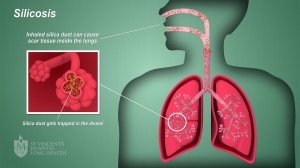From an Opinion Editorial, Charleston Gazette Mail, August 30, 2022
It was a small remark. You could’ve almost missed it. Many probably did. A little less than two weeks ago, Sen. Joe Manchin, D-W.Va., was in a roundtable discussion in Charleston, surrounded by supporters of the recently signed Inflation Reduction Act.
Among the group was United Mine Workers of America President Cecil Roberts, who was there to voice his support for the portion of the act that permanently funds the Federal Black Lung Disability Trust. Before going into why he supports the legislation, Roberts made a brief, almost quiet statement about the need to address silica dust in the mining industry. It was an aside, but it was important.
As many readers know, black lung is a condition among miners resulting from the buildup of dust in the lungs, which, over time, affects a miner’s ability to breathe and can be fatal. Traditionally, the problem stemmed from exposure to coal dust over years, and miners would develop the condition late in their career or after they had retired. Improved safety standards, including better ventilation in mines, helped reduce the disease.
Then, the number or cases started surging again. By 2018, black lung cases were at a 25-year high and miners were developing severe cases at much younger ages. The problem was — and remains — particularly bad in Appalachian mining states, like West Virginia. The suspected culprit was silica dust. A study authored by several physicians and researchers released earlier this year supports that conclusion.
The coal industry has been in a long decline, with brief booms here or there. Many factors have played into this broad trend and, in West Virginia, one of those factors is depleted coal seams. There just isn’t as much of the stuff underground as there used to be. What is there is hard to access. For years, miners have had to cut through sandstone to reach extractable coal. That releases silica dust, which is composed of microscopic crystals.
As miners inhale the dust, their lungs are punctured. Over time, this leads to an irreversible buildup of fluid in the lungs. Miners are unable to work and are placed on oxygen tanks. Just walking across a room can be exhausting.
Eventually, they suffocate to death. This is happening to miners at younger and younger ages because silica inhalation is more severe and, unlike coal dust or any number of other air quality pollutants in a mine, exposure to silica dust isn’t well-regulated. It’s a longstanding problem that the government has failed to address.
In fact, regulatory officials under presidents Bill Clinton, George W. Bush, Barack Obama and Donald Trump tried to come up with ways to handle the problem, but weren’t able to accomplish much. Their efforts typically stalled out once coal lobbyists and industry attorneys got involved, which is a familiar story to West Virginians.
However, in June, the Mine Safety and Health Administration announced another initiative to try and regulate the problem through increased inspections at coal mines with a history of overexposure to silica; increased enforcement and oversight; expanded air quality testing; inspection of mining techniques to ensure unnecessary amounts of dust aren’t released; and frequently reminding miners of their right to report violations. Roberts released a statement at the time praising the effort. Time will tell if it’s successful.
The Black Lung Trust makes sure miners with this awful condition have their medical expenses covered when their employers can’t do so or have shirked responsibility through bankruptcy. It’s an essential service, and making sure it is funded is crucial to many West Virginians. What would be even better is preventing the condition wherever possible. Hopefully, this new initiative will prove effective.
CHECK OUT THE WEBSITE: wisair.wordpress.com and for additional information, click here for panoramic aerial views of frac sand mines, processing plants, and trans-load facilities. FracTracker.org is also an excellent source of information and a picture source.
SOURCE: FRAC SAND SENTINEL | 561 SUMMIT AVENUE, Chippewa Falls, WI 54729


{ 2 comments… read them below or add one }
Cheers & Jeers, Uniontown Herald Standard, Sep 9, 2022
HIT: Last week, the Lungs at Work nonprofit clinic in Waterdam Plaza in McMurray received some ink, thanks to a visit from U.S. Sen. Bob Casey. He was there to see how the clinic lends a hand to former miners who have black lung disease, and also to promote legislation that would, among other things, ensure that miners’ benefits are not eroded by inflation and they have access to legal representation.
Lungs at Work deserves the moment in the spotlight Casey’s visit provided. It’s the only free-standing black lung clinic in the country, and the staff at the facility carry out essential diagnostic work and medical care. They also help miners file disability claims when they are found to have black lung, which scars the lungs and slowly takes away the ability to breathe.
Casey pointed out that miners helped power American prosperity over many decades, and those who have black lung should be given the care they deserve.
Oh, hello! Wow, if it wasn’t for this article I wouldn’t even know that miners’ lungs are pierced as a result of the dust they breathe in which causes a gradual but irreversible accumulation of fluid in them. I need to alert my sister-in-law about this and make sure she calls a legal expert to get all the relevant paperwork done. She has a neighbor who works at a coal mine and fell sick yesterday after having some difficulty breathing; I bet it was caused by his daily job there.